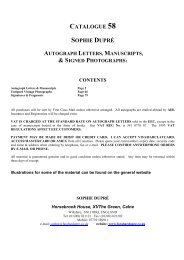CLIVE FARAHAR Catalogue 60
CLIVE FARAHAR Catalogue 60
CLIVE FARAHAR Catalogue 60
You also want an ePaper? Increase the reach of your titles
YUMPU automatically turns print PDFs into web optimized ePapers that Google loves.
107. [MALCOLM (Sir John)] Sketches of Persia from the Journals of a Traveller in the East,<br />
1827 some spotting at front and back, 2 vols, 8vo, hf. green calf, rebacked with new end<br />
papers, [10585] £350<br />
Although always listed as being by Sir John Malcolm, the author in his introduction to this work seems<br />
to distance himself from the great man, describing himself, perhaps disengenously, thus - “Nothing that<br />
had hitherto appeared respecting Persia at all frightened me. I am no historian, therefore I did not<br />
tremble at Sir John Malcolm’s ponderous quartos; I am no tourist, Mr. Morier’s Journeys gave me no<br />
uneasiness; the learned researches of Sir William Ousley were enough to terrify an antiquarian, but<br />
that was not my trade; and as I happen to have clumsy, untaught fingers, and little if any taste for the<br />
picturesque, I viewed, without alarm, the splendid volumes of Sir Robert Ker Porter.”<br />
ESSAYS ON CHINA, THE MIDDLE EAST AND HERESY.<br />
108. MANUSCRIPT Collection of Articles and Essays titled “Apothegms”, “Actions and Sayings<br />
of the Chinese Emperors”, “A Particular Account of the Tartars Irruption into China”, in 1664,<br />
the Quing Dynasty,“The Genealogy of the Great Moguls”, “The Genealogy of [the] Family<br />
now Raigning in Persia”, “The Chronology and Sucession of the Ottoman Monarchy”, and “Of<br />
All Known Heretics and Others”, c.1705 450 pp. in a fine hand with names and quotations in<br />
red ink, 3 leaves with portions cut out, some other tears repaired, folio, aeg, contemporary calf,<br />
rebacked, [12619] £2,500<br />
The date of this anonymous manuscript would appear to be late 17th century. In the section on Persia<br />
the author says “Mustapha II now reigning...” and he reigned from 1695-1703. In the section on<br />
“Hereticks” the author writes about New Spain and the idolatry of “These wretched Americans...”.<br />
Also about the religious or heretical customs of Peru, Brazil Siam, Sumatra, Phillippines, the Persians,<br />
the Muscovites, Mexicans, Turks, Malabar, the Congo, from all parts of the world, as well as more<br />
home grown sects such as Muggletonians and Brownists.<br />
The anonymous author must have had access to a large scholarly library to collect this material and<br />
interpret it, although there appears little comment. From the “Heretics” we may gather that the<br />
compiler is a High Church Anglican, probably a non-juror. living in London (p. 392 under “Quakers”).<br />
This portion is arranged as a dictionary, and the material on exotic religions comes apparently from<br />
Purchas, the more recent from the compiler’s own knowlege and strong opinions.<br />
The most striking essay is the first, 51 pages, entitled simply “Apothegms”, extracts or maxims. Its<br />
flavour is distinctly Confucian. It derives from a work little known today in the West, the “Ming Xin<br />
Bao Jian”, “The Perfect Mirror to throw Light on the Mind”, an elementary treatise on philosophy. It<br />
was the first Chinese book to be translated into any western language, by a Dominican at Manila in<br />
1593, but remained in manuscript. Another Dominican at Manila, Domingo Fernandez Navarette, who<br />
knew China and its language well, included a version in his “Tratados historicos, politicos, ethisos y<br />
religiosos de la monarchia de China”, Madrid, 1676. No substantial portion of Confucius was<br />
published in the west till 1687 in Paris. The only translation in English of the “Tratados” is in<br />
Churchill’s Voyage, vol 1, 1704 or later edition, from Book IV, of which the present excerpts have been<br />
skilfully and sympathetically chosen, two classical Greek anecdotes being added at the end. The<br />
Confucius’ Anelects appear to be almost in random order, the Ming Xin Bao Jian has a more developed<br />
style, being compiled from all the great early sages in an attractive and more regular manner, which the<br />
present excerpter has maintained and enhanced by omitting sources, so as to read as a connected<br />
whole. The second essay, “Actions and sayings of the Chinese Emperors”, beginning with the Tai Zung<br />
Emperor, Tang Dynasty, is similarly drawn from the “Tratados” Book II, chapter 15 onwards, with<br />
many good stories from Fernandez Navarette’s deep reading of Chinese Histories, again hard to come<br />
by in convenient form in translation.<br />
We may suppose that the present excerpter was attracted by material highly suitable for discourse from<br />
the pulpit or for other writing. He also shows his respect by omitting anything that Navarette has<br />
supplied for comparison, for example from Thomas Aquinas<br />
109. MARRYAT (Frank S.) Borneo and the Indian Archipelago. With Drawings of Costume and<br />
Scenery, 1848 tinted lithograph frontis and title 20 other plates, woodcut text illusts. some<br />
marginal foxing affecting a few plates, roy. 8vo, hf. calf, [11308] £2,000





